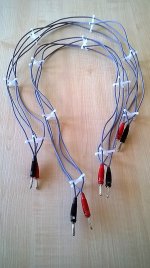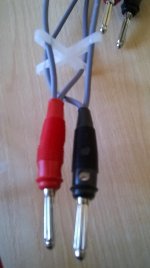For some years I have been using self-built star-quad cables, I am satisfied and would like to know if anyone has tried similar cables.
The very low 30 pF / m capacitance makes the cable suitable even for amplifiers with low output currents. In the 662g cables the four conductors are connected to the + and - phases of the signal diagonally. They are kept approximately 25mm apart with plastic cross brackets. The capacitance between two conductors decreases with distance, even with some points where the cables approach the average capacitance remains at around 30 pF / m.
An aspect not considered of the speaker cables is that compared to the system they behave like the primary winding of a transformer. At 10 KHz the electromagnetic waves have a wavelength of about 10 Km and at the audio frequencies the whole audio system is subjected to the homogeneous flow of the magnetic field generated by the speaker cables. The star-quad configuration reduces the magnetic field generated by the current sent to the speakers and minimizes the chained flux with the amplifier circuits and signal cables. The possibility of unwanted feedback is reduced.
The cable is very cheap on page 662g you can find other photos to make a replica.
The very low 30 pF / m capacitance makes the cable suitable even for amplifiers with low output currents. In the 662g cables the four conductors are connected to the + and - phases of the signal diagonally. They are kept approximately 25mm apart with plastic cross brackets. The capacitance between two conductors decreases with distance, even with some points where the cables approach the average capacitance remains at around 30 pF / m.
An aspect not considered of the speaker cables is that compared to the system they behave like the primary winding of a transformer. At 10 KHz the electromagnetic waves have a wavelength of about 10 Km and at the audio frequencies the whole audio system is subjected to the homogeneous flow of the magnetic field generated by the speaker cables. The star-quad configuration reduces the magnetic field generated by the current sent to the speakers and minimizes the chained flux with the amplifier circuits and signal cables. The possibility of unwanted feedback is reduced.
The cable is very cheap on page 662g you can find other photos to make a replica.
Attachments
Last edited:
Very interesting way to avoid using that ugly word "inductance," however I much prefer capacitance over inductance. Or was that some more unwanted feedback?
I made this 662g low-capacity cable after trying a three-phase, four-pole, high-capacity cable that sent my class D amplifier (Teac a-h01) into thermal protection.
I think speaker cables are to be considered antennas capable of disturbing the rest of the system and I chose the star-quad configuration which decreases the magnetic field flux in the listening room by at least an order of magnitude. The inductance in series of the cable is negligible compared to that of the voice coil of the speaker but unlike this it generates a magnetic flux even close to the amplifier terminals.
I have no measurements related to inductance or simulated model calculations.
I think speaker cables are to be considered antennas capable of disturbing the rest of the system and I chose the star-quad configuration which decreases the magnetic field flux in the listening room by at least an order of magnitude. The inductance in series of the cable is negligible compared to that of the voice coil of the speaker but unlike this it generates a magnetic flux even close to the amplifier terminals.
I have no measurements related to inductance or simulated model calculations.
Last edited:
The magnetic field 10 conductor spacings away from the cable is gone. If the conductors are 2mm center to center, 2 centimeters out is clean.
Jn
Jn
... however I much prefer capacitance over inductance.
I opened this thread after reading part of Analysis of speaker cables. I couldn't figure out if my star-quad cable with spaced conductors is suitable for Hi-End systems, I use it with cheap components.
I have already read another time that a low inductance is more important than a low capacity. Now it is clearer to me. At audio frequencies, speaker cables can disturb other system components if the flux of the generated magnetic field is linked with other circuits. A low inductance measures low stored magnetic energy and minimizes the effects of magnetic field fluxes chained between two circuits.
One way to minimize inductance is to bring the conductors closer by increasing the capacity of the cable. The drawback of this choice is that the amplifier must be able to handle the extra power needed to charge and discharge the capacitor (cable).
On page 662g I will add the advice to use the star-quad cable connected to limited power amplifiers. The capacity of the star-quad cable is greatly reduced without excessively increasing the inductance. Sooner or later I will take measurements.

